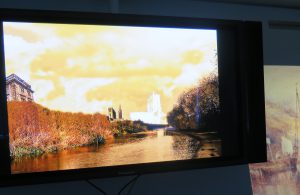August 11, 2017, by Matt Davies
Inspiring Slides: J.M.W. Turner’s ‘Nottingham’, 1832 by Marina Phelps
The latest in our Inspiring Slides posts comes from History of Art graduate and DHC alumna Marina Phelps who was inspired by one of the slides from the recent ‘Then and Now’ exhibition here in DHC.
J.M.W. Turner’s Nottingham, 1832, is one of two watercolours that he painted of Nottingham. The first was in 1794, and the second, seen in this slide, in 1832. Turner re-visited Nottingham, as a subject, for his Picturesque Views in England and Wales series of engravings which ran from 1827 until 1838. While the two views Turner produced of Nottingham are very similar, this second image shows how the political landscape had changed in Nottingham between his two attempts at painting the city. The castle in this later view has now been pushed further out of the frame, hinting towards the unrest that had happened in Nottingham during the early 30s. Nottingham had become the centre of the civil unrest throughout England which led to the parliamentary Reform Bill of 1832. The castle’s owner, the Duke of Newcastle, was one of the main opponents of reform, which led to people in the city rising up and attacking his mansion, burning it and all its contents. The drawing was meant by Turner, it has been suggested, as a symbolic celebration of the passing of the Reform Bill.
The main features of Turner’s watercolour are the castle, canal and the three main churches of Nottingham; St. Nicholas, St Peter’s and the most recognisable, the gothic Church of St. Mary the Virgin to the right of the frame, in the distance of the view. Turner’s composition is interesting in terms of how he has chosen to represent the city’s waterways. In traditional images of the city, it is more common for the River Trent to occupy the prominent place which Turner has here given to the canal instead. This may be Turner’s way of celebrating the modern technology of his day, similar to his painting Rain, Steam and Speed of 1844.
Turner’s view of Nottingham was exhibited as part of the DHC’s Then and Now:People and Place in Nottingham exhibition which ran from the 3rd– 7th April 2017. In the exhibition a projection of the 35mm slide was contrasted with a digital image produced in the DHC using Photoshop. Using photographs of the same stretch of river and buildings that Turner painted, student volunteer Athanasia Panopoulou recreated Turner’s landscape to show how he altered the position of some of the features to create his idealised image.
To find out more about the Then and Now exhibition see here.

Installation shot from Now and Then exhibition shows DHC volunteer Athanasia Panopoulou’s digital reworking of Turner’s ‘Nottingham’.
No comments yet, fill out a comment to be the first

Leave a Reply